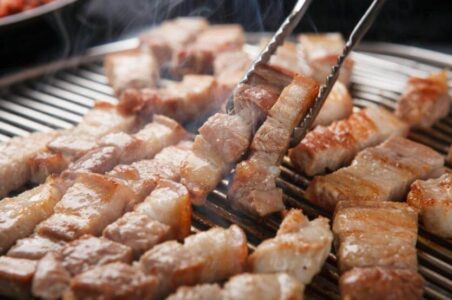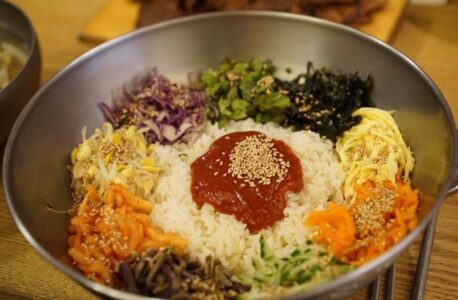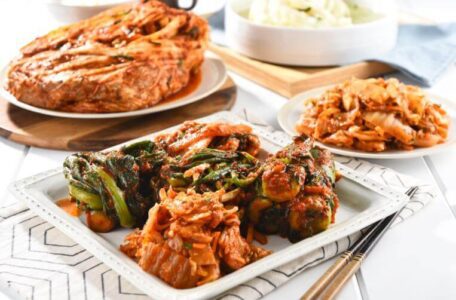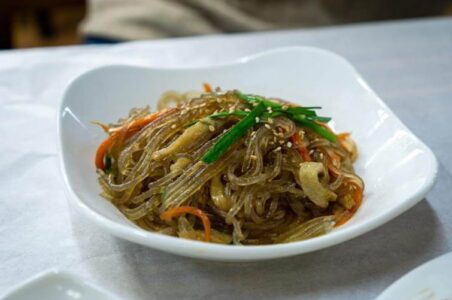Korean food has been gaining fashionability in recent times, and for good reason. With its bold flavors, different constituents, and artistic significance, Korean cookery offers a unique and instigative dining experience. In this composition, we will explore the world of Korean food, from its history and culinary traditions to its health benefits and popular dishes. Join us on this succulent trip and discover the prodigies of Korean cookery.
Table of Contents
- Introduction: Why Korean Food is Worth Exploring
- A Brief History of Korean Cuisine
- Ingredients and Flavor Profile of Korean Food
- Korean Spices and Sauces
- Popular Korean Ingredients
- Health Benefits of Korean Food
- Fermented Foods and Gut Health
- Nutritious Ingredients in Korean Cuisine
- Popular Korean Dishes to Try
- Korean BBQ
- Bibimbap
- Kimchi
- Japchae
- Korean Food Culture and Traditions
- Dining Etiquette in Korea
- Festivals and Celebrations
- Where to Find Authentic Korean Food
- Conclusion
- FAQs
Introduction: Why Korean Food is Worth Exploring
Korean cookery is a feast for the senses, combining a variety of flavors, textures, and colors. From savory grilled flesh to racy stews and pungent pickled vegetables, there’s commodity for everyone in Korean food. But Korean cookery isn’t only about the taste – it also reflects the history, culture, and terrain of the Korean promontory. Exploring Korean food is like taking a trip through the country’s history and present, as well as its geography and people. Whether you’re a savorer, a rubberneck, or simply curious about the world, Korean food is surely worth trying.
A Brief History of Korean Cuisine
Korean food has a long and rich history that dates back to ancient times. The first Korean cookbook,” Gyuhapchongseo,” was written in the late 17th century and contained over 1000 fashions. Korean cuisine has been told by skirting countries analogous as China, Japan, and Mongolia, as well as by its own indigenous ingredients and cookery styles. The Korean promontory’s terrain, with its mountains, beachfronts, and rich dales , has also played a part in shaping the country’s food culture. Korean food has evolved over time, reflecting the social, political, and profitable changes of the country, but it has always maintained a distinct identity and flavor
Ingredients and Flavor Profile of Korean Food
Korean cuisine is known for its use of bold flavors, including spicy, salty, sweet, and sour. Korean dishes often feature a combination of flavors in one bite, creating a complex and harmonious taste. Some of the key ingredients in Korean food include:
Korean Spices and Sauces
- Gochujang: a fermented chili paste that is used in marinades, sauces, and stews.
- Doenjang: a fermented soybean paste that is similar to miso and used as a seasoning in soups and stews.
- Gochugaru: a coarse red pepper powder that is used in kimchi, marinades, and sauces.
- Sesame oil: a fragrant oil made from roasted sesame seeds that is used in dressings and marinades.
Popular Korean Ingredients
- Rice: a staple food in Korea, eaten with almost every meal.
- Meat: beef, pork, and chicken are common meats in Korean cuisine, often marinated and grilled.
- Seafood: Korea’s long coastline provides a variety of seafood, including squid, octopus, and fish.
- Vegetables: Korean cuisine features a wide range ofvegetables, including leafy greens, root vegetables, and wild herbs.
- Tofu: a protein-rich food made from soybeans, often used in stews and soups.
- Kimchi: a spicy, fermented side dish made from cabbage or other vegetables, which is a staple in Korean cuisine.
Health Benefits of Korean Food
Korean cuisine offers many health benefits, thanks to its emphasis on fresh ingredients, fermented foods, and a balanced diet. Some of the health benefits of Korean food include:
Fermented Foods and Gut Health
Korean cuisine is rich in fermented foods, such as kimchi, doenjang, and makgeolli (a fermented rice wine). Fermented foods are beneficial for gut health, as they contain probiotics that can improve digestion and boost the immune system.
Nutritious Ingredients in Korean Cuisine
Korean food features many nutrient-dense ingredients, such as vegetables, seafood, and tofu. These foods are low in calories and high in vitamins, minerals, and antioxidants, making them a healthy choice for anyone looking to improve their diet.
Popular Korean Dishes to Try
Korean cuisine offers a wide range of dishes, from simple street food to elaborate banquets. Some of the most popular Korean dishes include:
Korean BBQ

Korean BBQ is a beloved dish that involves grilling marinated meat at the table. The meat is often served with lettuce leaves, which are used to wrap the meat and other toppings, such as kimchi and ssamjang (a spicy dipping sauce).
Bibimbap

Bibimbap is a colorful and nutritious dish that features rice, vegetables, and a protein (such as beef, chicken, or tofu). The ingredients are arranged in a bowl and topped with a fried egg and a spicy sauce.
Kimchi

Kimchi is a spicy, fermented side dish that is served with almost every meal in Korea. It is made from cabbage or other vegetables that are pickled with spices and chili paste.
Japchae

Japchae is a stir-fried dish that features glass noodles made from sweet potato starch, along with vegetables and meat (such as beef or pork). The dish is flavored with soy sauce, sesame oil, and sugar.
Korean Food Culture and Traditions
Korean food isn’t only about the taste – it also reflects the culture and traditions of the Korean people. Then are some of the artistic aspects of Korean cookery
Dining Etiquette in Korea
Dining Form in Korea Korean dining form involves numerous customs and rituals, similar as using tablewares and ladles in a certain way, participating dishes with others, and showing respect to elders and guests. It’s important to be familiar with these customs when dining in Korea
Festivals and Celebrations
Korean cookery is an integral part of numerous carnivals and fests in Korea, similar as Lunar New Year and Chuseok( the crop jubilee). These occasions frequently involve special dishes and rituals that reflect the significance of the event.
Where to Find Authentic Korean Food
still, there are numerous options available, If you’re interested in trying Korean food. Korean caffs
can be set up in numerous metropolises around the world, and there are also Korean grocery stores that vend constituents and set foods. It’s also possible to make Korean food at home, using fashions and constituents that are extensively available.
Conclusion
Korean food is a vibrant and instigative cookery that offers a unique dining experience. From its bold flavors and different constituents to its artistic significance and health benefits, Korean cookery has commodity for everyone. Whether you’re a savorer, a rubberneck, or simply curious about the world, Korean food is surely worth exploring.
FAQs
- What is the national dish of Korea?
- There is no one “national dish” of Korea, as Korean cuisine features a wide variety of dishes. However, some popular dishes that are often considered to be representative of Korean cuisine include kimchi, bibimbap, and bulgogi.
- Is Korean food spicy?
- Korean cuisine is known for its bold flavors, which often include spicy elements such as chili paste and red pepper powder. However, not all Korean dishes are spicy, and there are many mild and savory dishes to try as well.
- Is Korean food healthy?
- Korean food can be very healthy, as it emphasizes fresh ingredients, fermented foods, and a balanced diet. Many Korean dishes are low in calories and high in nutrients, making them a good choice for anyone looking to improve their diet.
- What is the difference between Korean BBQ and other types of BBQ?
- Korean BBQ is unique in that it is often grilled at the table, allowing diners to cook the meat to their liking. Korean BBQ also typically involves marinating the meat in a flavorful sauce beforehand, which gives it a distinctive taste.
- What is the best way to enjoy Korean food?
- The best way to enjoy Korean food is to try a variety of dishes and flavors. Korean cuisine is meant to be shared, so it is common to order several dishes and share them with others. Don’t be afraid to try something new and embrace the bold flavors and textures of Korean food.
- What are some popular Korean snacks?
- Korean snacks are a popular and delicious part of Korean cuisine. Some popular snacks include tteokbokki (spicy rice cakes), kimbap (rice rolls with various fillings), and hoddeok (sweet pancakes filled with cinnamon and sugar).
- Is there vegetarian/vegan Korean food?
- Yes, there are many vegetarian and vegan options in Korean cuisine. Tofu and various vegetables are commonly used in Korean dishes, and there are also dishes such as bibimbap that can be made without meat.
- What is the significance of kimchi in Korean cuisine?
- Kimchi is a staple in Korean cuisine and is served with almost every meal. It is a symbol of Korean culture and has a long history that dates back to ancient times. Kimchi is also known for its health benefits, as it is a fermented food that contains probiotics and other nutrients.
- What are some traditional Korean drinks?
- Korean cuisine features a variety of traditional drinks, such as makgeolli (a fermented rice wine), soju (a clear distilled liquor), and sikhye (a sweet rice drink). These drinks are often served with meals or enjoyed on their own.
- Can I find Korean food in my area?
- Korean cuisine has become increasingly popular in recent years, and Korean restaurants can be found in many cities around the world. You can also try making Korean food at home using recipes and ingredients that are widely available.
👉Korean Food Frankfurt: Best Korean Restaurants in Frankfurt
